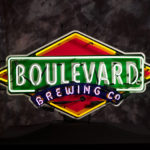For maximum brand impact in a retail environment, there’s nothing better than illumination. Particularly for Point-of-Sale applications, an illuminated sign offers high visibility and brand retention characteristics.
The two most widely-used light sources today are LEDs and Neon. And for good reason. Both are bright, energy-efficient, long-lasting, and good value-for-money. But there are differences needing to be understood so as to make the best choices.
A Neon is essentially an illuminated tube. An LED is a solid-state device. There are advantages and drawbacks to both, very much dependent on desired effect and applied use. LEDs, by nature, are more of a pinpoint light source. In order to provide even dispersion of lighting, many LEDs are used either in clusters or linear arrays. Some LED modules have built-in lenses to spread the light. Conversely, Neon tubes are linear light sources, also possessing some 360-degree traits.
Relative costs of purchase are equal. Light efficiencies in lumens per watt are also relatively equal. Efficiency is very much dependent on color selection with whites being the most efficient.
LEDs get the nod for more durability and versatility. They are relatively unbreakable. And, being small, compact, and low-voltage devices, they can be fit into tight places and in close proximity to other materials. LEDs are great for backlighting of translucent, printed plastics. They are excellent for halo effects as well. Note that with present-day LED technology, color selection of individual LEDs is limited. Most-available are red, blue, green, amber, and various whites.
Neon has definite advantage for making outstanding bold, bright statements. By nature, they lend a fair amount of dimensionality to a sign design.
More significantly, Neon is an art medium. It has 100 years of use in commercial advertising applications. It has history. It is iconic in many ways. Neon evokes emotion, triggers memories (both obvious and subliminal), and suggests a variety of moods and past experiences. Craft brewers are particularly drawn to it for its aesthetic appeal. After all, Neon is a “craft” as well. And is often perceived to have high “cool” factor.
 Obviously there is an inherent breakage risk to using a glass-tube light source. But if manufactured well and treated with some respect they are not overly fragile.
Obviously there is an inherent breakage risk to using a glass-tube light source. But if manufactured well and treated with some respect they are not overly fragile.
Neither LED nor Neon signs last forever. That said, a good sign, whether Neon or LED should easily last 5 years. 10-year service life for Neon signs is not unusual. There are even neons continuing to function after 30 to 40 years. Since LEDs have not been used in sign apps for more than 15 years, their longevity is unknown. Early LEDs did not completely live up to claims of life. But, LED technology continues to evolve. And quickly.
One last sub-topic to cover before closing… serviceability. Here, Neon gets the nod. Components can easily be replaced. New tubes can be made. Power supplies are readily available. As are the people with knowledge to do the work. For LEDs, not. When LEDs fail, it’s almost impossible to replace individual devices. The less-than-desirable remedy is to rip them all out and start over.
Look for more in-depth coverage of illuminated choices in future issues.
All photos courtesy of Antigo Zeon
